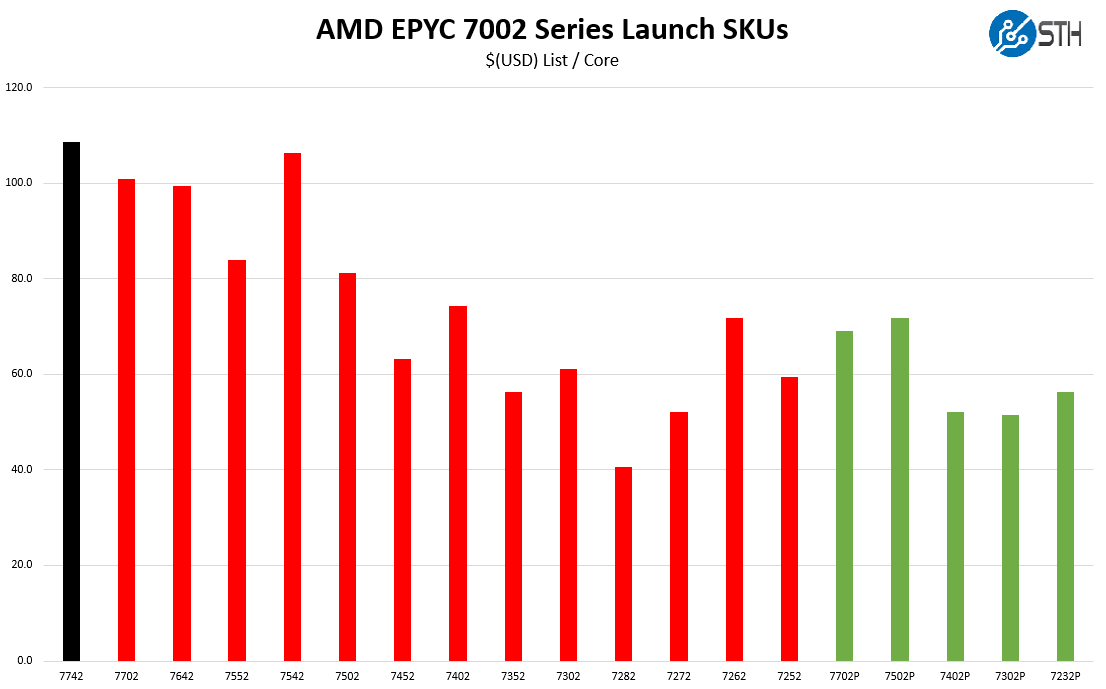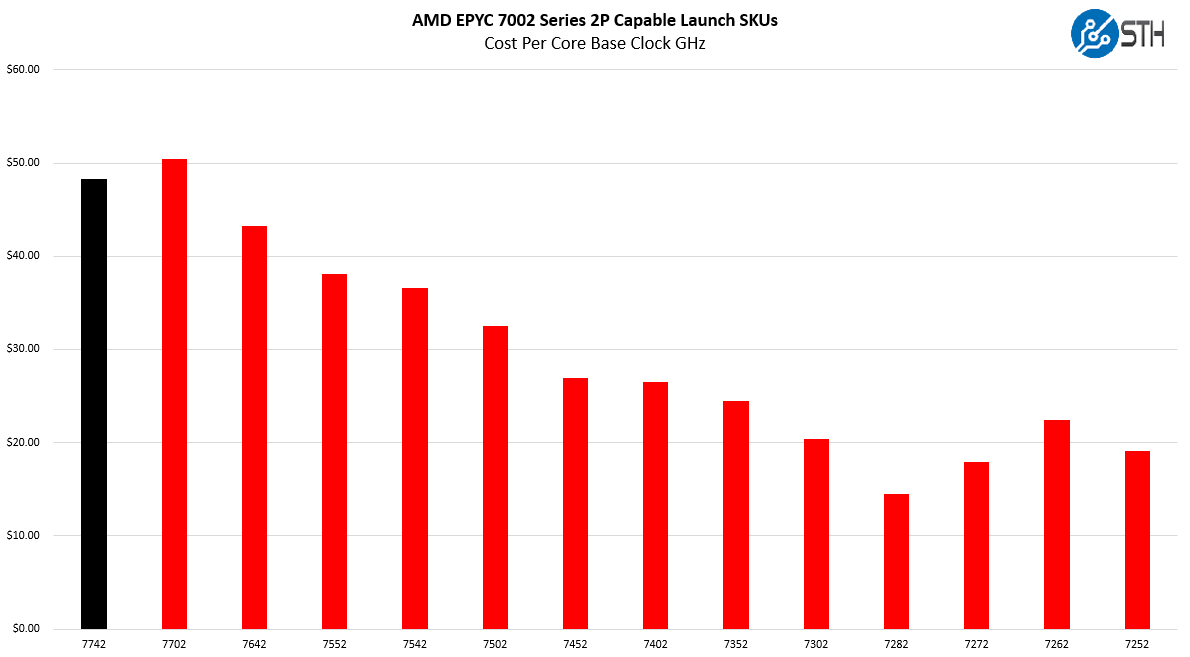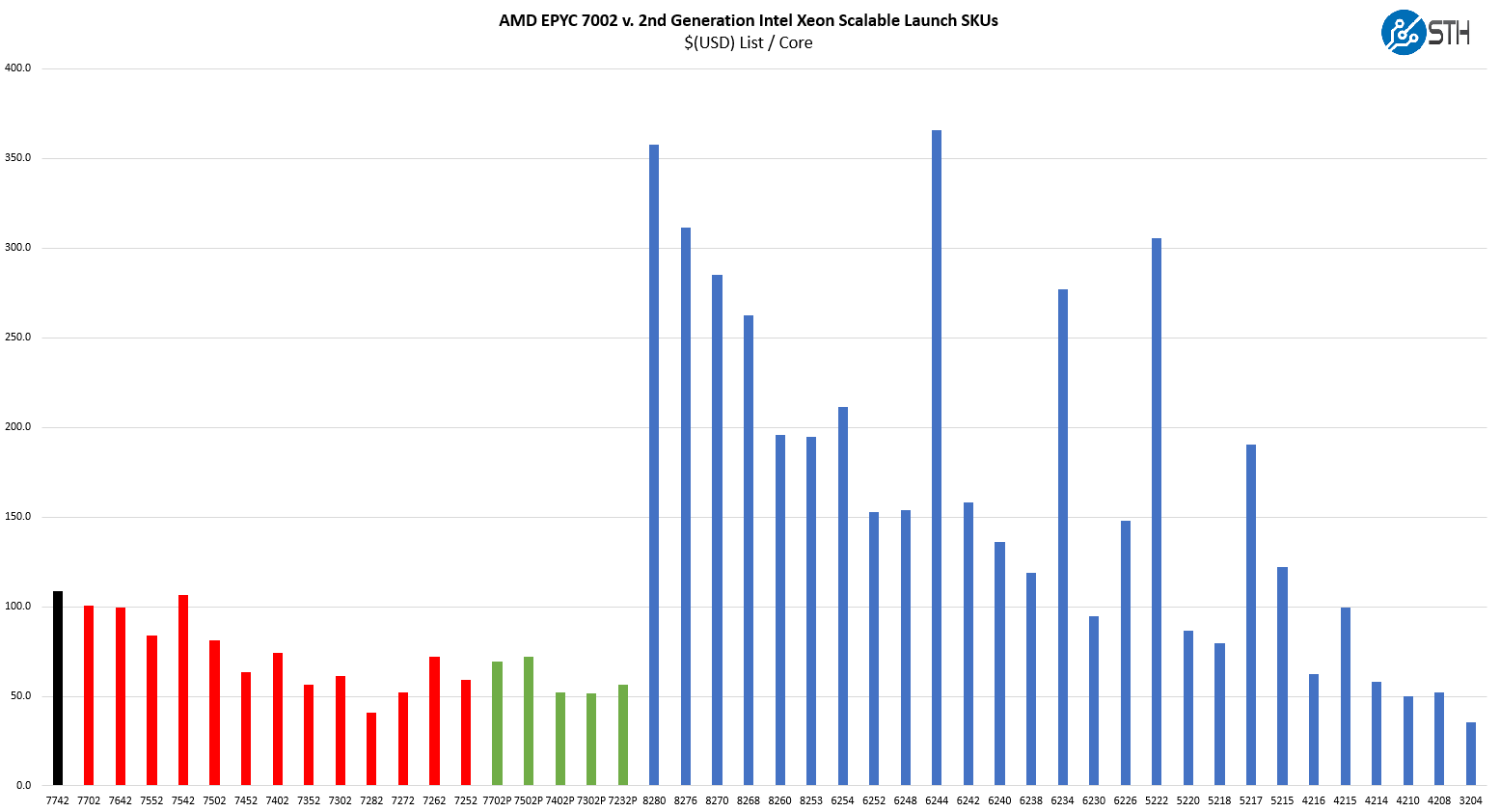AMD EPYC 7742 Market Positioning
Thes chips are not released in a vacuum instead, they have competition on both the Intel and AMD sides. When you purchase a server and select a CPU, it is important to see the value of a platform versus its competitors.
AMD EPYC 7742 v. AMD Alternatives
When we look at the AMD EPYC 7742 compared to other AMD EPYC 7002 series offerings, we see that it is on the top of the pricing spectrum. You can read more about AMD’s SKU methodology in our piece AMD EPYC 7002 SKU List and Value Analysis.

Here you can see that pricing per core is the highest among its stablemates for single-socket applications. We are looking simply at SKU pricing here. On a TCO basis, there are clear benefits to using a larger CPU.
When we look at a cost per base core clock (list in $USD/ cores * base GHz), we can see that it is still at the higher-end of AMD’s stack.

For a single-socket application, our guidance is likely to be the EPYC 7702P which is a significantly lower list price part yet offers many of the same features and much of the same performance. For dual-socket applications, the EPYC 7742 is a very strong option.
As a quick generational note, AMD has essentially doubled the core count over the EPYC 7601 and is offering more than twice the performance. If you did TCO calculations on AMD EPYC 7601 generation CPUs, there is likely an enormous delta between generations. If you are comparing compute cost versus cloud compute nodes, this is going to completely change the value equation.
We are using a single-socket platform here just to put a focus on the comparison to the Intel Xeon stack. If we had used dual-socket AMD EPYC 7742 configurations, we would have had to move to quad-socket Intel Xeon Scalable platforms for comparison sets.
AMD EPYC 7742 v. Intel Xeon Alternatives
If you have not read the performance section, please do so for context. Then look at this chart which shows the first chart from our AMD EPYC 7742 v. AMD Alternatives section above alongside its Intel counterparts:

The AMD EPYC 7742 is AMD’s highest list price part, but it is priced more similarly to Intel’s lower-end Xeon Gold 6200 series and higher-end Gold 5200 series. Said another way, AMD is setting a list price for the AMD EPYC 7742 more akin to how Intel prices mainstream parts.
We know Intel has been offering discounts to combat the AMD EPYC 7002 series even on smaller deal sizes. List prices, especially on its higher-end CPUs, are designed to have room for discounting. Assuming Intel is discounting the Xeon Platinum 8280 by 60-70%, it is competitive 2-for-1 against a list price EPYC 7742. There are plenty of quad-socket Xeon platforms on the market.
Intel does have the Xeon Platinum 9200 and is getting some traction in certain HPC segments, but it is effectively non-existent in the general-purpose CPU market. There is a big difference between a chip that can excel in virtualization along with other general-purpose workloads and one that has a niche defined by smaller segments of the HPC market.
Intel also has features like AVX-512 and VNNI. Perhaps the most compelling is Optane DCPMM. DCPMM in memory mode is the most common use case where it is used to expand memory. The App Direct mode where it is used as persistent storage is a game-changer for some applications. AMD does not have this feature. These are perhaps binary decisions on what one considers “must-have.” Note, if you are using 128GB DCPMMs in Memory Mode, it is not a “must-have” feature and instead AMD’s memory setup is likely to be better.
Realistically, Intel was supposed to have Ice Lake Xeons out with its new microarchitecture, PCIe Gen4, and more cores this year when the EPYC 7002 series launched. Instead, with Intel’s 10nm delays this AMD EPYC 7742 is essentially like later next year’s enormous performance jump halo Xeon, except it is available today from AMD and at a lower price.
Final Words
Let us take a moment to discuss the comparison that we used in this piece. Dual Intel Xeon Platinum 8280 205W $10,009 list price CPUs versus a single AMD EPYC 7742 at 225W and $6,950 list price. That AMD EPYC 7742 technically has more PCIe I/O lanes and bandwidth with PCIe Gen4 support. It also does not utilize a PCH. One must remember that in addition to the CPUs, Intel platforms have additional TDP and cost in the Intel Xeon SP Lewisburg PCH.
That is absolutely an accomplishment for the AMD engineering team. There is a bit of luck in there as well since Intel is likely a year or so behind AMD with its Ice Lake Xeons which are unlikely to have the same core count but will add PCIe Gen4 and an updated microarchitecture in 10nm.
The bottom line is this: if you are buying servers right now, and not at least pricing out AMD EPYC 7002 series CPUs, whether that is the EPYC 7742 or another lower-end SKU, then you are effectively wasting money for your organization. If you have employees who are not bringing you competitive AMD EPYC 7002 quotes along with Xeon quotes, then they are not doing their jobs getting competitive bids. In a world where AMD only has a 0-20% performance edge, that would not be the case. Instead, AMD’s price and performance is closer to 2x. Even for many corporate contracts with large IT vendors like Dell and HPE where putting volume against certain SKUs yields discounts, the AMD EPYC 7742 can have a big enough impact that renders those discounts not attractive. This is especially so with use-cases such as general virtualization platforms where AMD can consolidate multiple mainstream Xeon sockets into each EPYC 7742 socket. If Intel is competing on price and selling what it has, great. If you are not evaluating EPYC 7742 or other SKUs in their stack, then you are not doing your organization justice.
As it stands, until Cooper Lake and Ice Lake Xeons hit, scheduled for 2020, the AMD EPYC 7742 is a peerless CPU in the market. Do your organization a favor and do your own due diligence on the EPYC 7002 series when planning purchases.




So basically the only reason you should even consider Intel is if they discount you 60% or you need AVX-512? What a fascinating time to be alive.
Really, a 60-70% Intel discount isn’t a good enough reason to stay with them. Absolutely needing AVX-512 or optane dimms is about the only reason.
Even if you get a 60-70% Intel discount you’re still getting it basically at what AMD charges, but you’re not getting the lower NUMA node count, lower TDP (hence lower electric/cooling costs), rack space savings, PCI gen4, etc, etc.
Thanks for not getting bogged in the weeds. Unlike your launch article, this is actually just right explain + data + editorial. You’ve gotten better.
“Most in the market will continue buying what they bought before.”
This is what we’ll be doing, for sure. Part of it is we just replaced ~half of our VM hosts 18 months ago with Intel (from HPE.) And since we would more likely than not be piecemeal replacing/adding additional servers in the future versus a forklift replacement, the pain involved from running VMware on split AMD/Intel isn’t work the headaches (no live vMotion.)
The other thing is that the person who makes the purchasing decisions isn’t interested in even looking at AMD’s cost/performance. In their mind, Intel is king and AMD is nothing but compatibility trouble. Since we aren’t currently up against a wall as far as colo power or space usage goes, the consolidation factor doesn’t do much for us.
How much longer before Micron launches a competitor to Intel’s NVM/3D-XPoint DIMMs and Micron has already announced its X100 NVMe SSD 3D-XPoint(QuantX branding) competition back in Oct of this year. AMD partners with Micron for GDDR6 along with others so maybe AMD and Micron can work up some Open Standards way of using XPoint based DIMMs on the Epyc/SP3, newer, platform and hopefully that development is already ongoing so that will remove one more reason to choose Intel.
However long it takes AMD to move up from Rome’s AVX256 to AVX512 AMD still has its GPU accelerator products for massive DP FP workloads but is that AVX512 market large enough to go after at this point in time for AMD on CPUs. Epyc/Milan is sure to improve performance once that CCX Unit construct is supplanted by just the 8 core CCD-DIE that shares among its 8 CPU cores the CCD-DIE’s total allotment of L3. And with the only question remaining to be answered is concerning the Zen-3 CCD-DIE’s actual Fabric Topology and will that be a Ring BUS(CCD Die Only) with inter CCD-DIE Infinity Fabric On Package interfacing or some more complicated topology with lower latency as well.
Epyc/Rome really marks the return of wider server/HPC market support for AMD with Epyc/Naples getting AMD’s foot back in the door in the mainstream server market. While AMD is getting some more HPC design wins with Epyc/Rome there are some larger supercomputer/exascale design wins that will be using custom Zen-3 Epyc/Milan offerings specifically targeting Direct Attached Radeon GPU accelerator interfacing via xGMI(Infinity Fabric) Links. So that’s similar to what Nvidia’s NVLink/NVLink2 is doing to interface the Tesla GPU accelerators to OpenPower Power9/Power10 on some HPC design wins.
AMD’s yearly Zen based CPU hardware/micro-architectural update cadence is now in full swing with no signs of any rough patches currently and TSMC’s 5nm apparently progressing faster than was expected. TSMC entered high volume production of its 7nm+ node in Oct 2019 and maybe some of that 20% density improvement claim will go into larger 8 core CCD-Die shared L3 or even AVX512 on some Epyc/Milan offerings.
Guy I think that’s the exact audience behavior he’s talkin’ about.
“The other thing is that the person who makes the purchasing decisions isn’t interested in even looking at AMD’s cost/performance. In their mind, Intel is king and AMD is nothing but compatibility trouble.”
Nobody ever got fired for buying Intel eh? …
When we will see the updated NAMD scores…? I’m really interested to see the uplift if any…
Support for Intel Optane NVMe SSDs is not a substitute for the Optane DIMMs in the new in-memory database applications that are taking advantage of Optane. Oracle is an example.
https://www.oracle.com/corporate/pressrelease/oow19-oracle-intel-partner-optane-exadata-091619.html
According to this article, Cooper Lake has been sampling since May. I presume big customers like FB are already using it. It would have 8 memory channels, avx512, bfloat16 and socketed 56 cores, according to the second link.
https://www.anandtech.com/show/14314/intel-xeon-update-ice-lake-and-cooper-lake-sampling
https://www.anandtech.com/show/14713/intel-to-offer-socketed-56core-cooper-lake-xeon-scalable-in-new-socket-compatible-with-ice-lake
Glad to see Tyan on the bench. They have a great AMD EPYC Rome story.
I’m looking at some DL325’s to replace an aging UCS environment from 2014. Was quite surprised at the lack of choice in HW vendors I had (out of the big players HP seemed to be the only ones that had something ready to go). My MSP seemed a little surprised I was asking about EPYC, too.
While on-prem hardware is no longer the flavour of the month where I am (and hasn’t been for some time) it’s still exciting for me to see how well AMD is doing.
Cooper Lake is still on 14nm, making TCO similar to 92xx Xeons. AVX 512 is no necessity in todays workloads (except AI HPC and other niches of course) Then you’re left with bfloat16, which is probably not utilized by anyone exept the HPC and AI guys, and Intel is left with the position AMD had when they launched Bulldozer for Server – funny how things changed
EPYC 7742 is definitely peerless in 2-CPU servers (comparable to quad 8280 which cost $$$$$).
For 1-CPU servers EPYC 7702P and/or dual 7452 are likely to have significantly better price-performance for most workloads.
@JayN, did you know that electricity is not free?
Also, am I the only one wondering why nobody says to these 99% intel discount arguments that giving discounted prices for high volume orders is not illegal for AMD either?
Just doing a refresh here and moving to all 7702P’s for virtualization hosts. When looking at Intel discounts it doesn’t even come close let alone the per-socket licensing savings. The only outside cost increase is with the WS DC farms which I’m sure Microsoft will be happy when renewals come.
Would AVX512 be nice to have? sure, but for the few workloads that really benefit a couple of GPU’s can handle the bulk of the use cases better for less $$$.
are the updated gromacs or other AVX512/256 results going to be posted in the end? We see them “promised” with the updated gromacs code for many reviews now, but nothing so far, or am I overlooking something? Thank you!
Stan – it took a while to get it stabilized. Now having to re-run everything which means swapping processors. Each swap means a trip to the data center. Slow going. We have been debating in the team whether to just move to a 2020 version and use a larger model as our standard going forward.
Please, *always* provide single core benchmarks even for server CPUs. There a lot of *very* expensive commercial software providers which sell licences per CPU core / per month, and so to pay less for those licencing fees one has strong incentive to buy servers with as fast single cores as possible. However, often all the benchmarks published focus on multi-core performance only.
We have been doing some network latency testing via sockperf using low latency NICs (from Exablaze). Sadly the latency is rather 3000ns instead of 700ns. Does anyone know of a special configuration to get these Dell/AMD boxes into a low latency mode ? We did use the right pcie slots… run cpus at full speed. have set kernel optimizations.